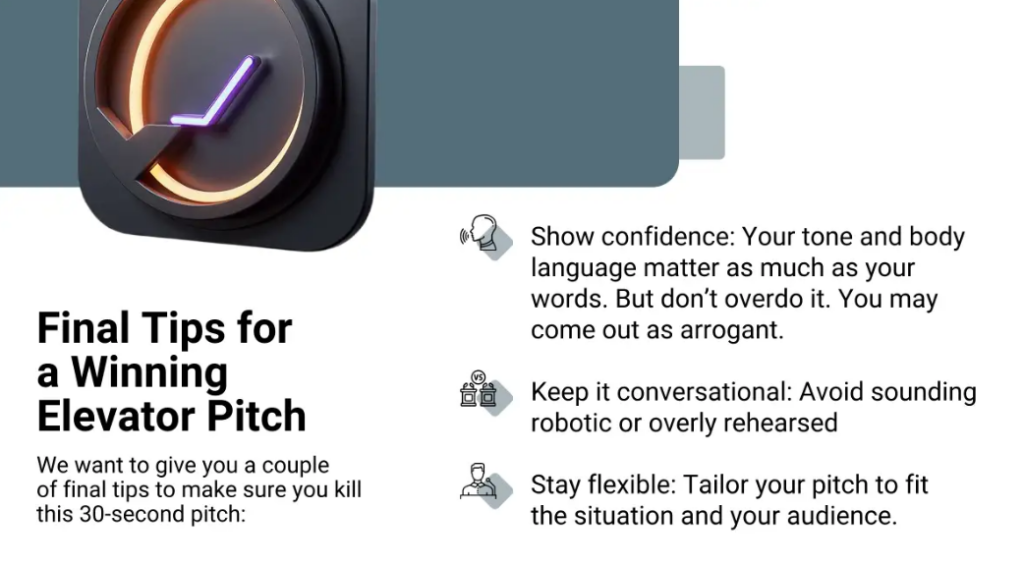We’re living in a fast-paced world where every second counts and an elevator ride can be a life-changing experience. A 30-second elevator pitch can help you find a dream job, sell an idea, or secure an investment.
So we decided it would be a good idea to explore this fascinating phenomenon – a 30-second elevator pitch. How is it different from a traditional sales pitch, and why is it effective?
We’ll also walk you through all the steps to craft your own 30-second elevator pitch.
What Is a 30-Second Elevator Pitch?
Let’s start with a definition. A 30-second elevator pitch is a concise, persuasive speech that highlights who you are, what you do, and what makes you or your idea stand out. The term “elevator pitch” comes from the idea that you should be able to deliver this speech in the time it takes for a short elevator ride—about 30 seconds.
It’s shorter than a more conventional 1-minute elevator pitch and probably more challenging to create, but who is giving in to a challenge? Not us.

Key Characteristics of a Good 30-Second Elevator Pitch:
- It’s short and to the point (roughly 75 words).
- It grabs the listener’s attention immediately.
- It’s easy to understand and memorable.
- It emphasizes your unique value or selling point.
When Can You Use the Pitch, and Why Is It Effective?
Let’s see where your 30-second elevator pitch can come in handy:
- Networking events: You can introduce yourself to potential collaborators or employers. An effective elevator pitch will grab their attention.
- Job interviews: It’s a strong answer to questions like, “Tell me about yourself” that are always asked at job interviews.
- Sales and business meetings: You can pitch a product, service, or idea in just 30 seconds.
- Conferences and expos: An excellent elevator pitch will make a lasting impression on industry professionals.
- Social settings: Even in a relaxed social environment, you can turn casual conversations into meaningful connections (just don’t go overboard with it and scare a potentially useful contact off.)
What makes a 30-second elevator pitch effective? There are several factors at work here:
- First impressions matter: People form opinions quickly (in the first couple of seconds, in fact), and a great pitch ensures you’re memorable for the right reasons.
- Saves time: A clear, concise message communicates your value efficiently, and you’ll see immediately if there’s a need to push further.
- Builds confidence: It can be terrifying the first time, but it’s a fantastic way to learn to present yourself with confidence. Preparing a pitch in advance helps to reduce the stress of introducing yourself on the spot.
Step-by-Step Guide
Crafting an effective 30-second elevator pitch is not the easiest task, yet quite doable. You just need to make every second count. Here’s how to get started:
1. Start With Who You Are
Begin by introducing yourself. This should include your name and a brief description of your current role or background. Make it relatable, friendly, and very short.
Here’s an example where a university graduate gives a 30-second elevator pitch to potential employers. He speaks about his educational background and experience succinctly, focusing on the most important aspects.
2. Highlight Your Unique Value
This is the “hook” of your pitch. Share what makes you different or what problem you solve. Use specific metrics or achievements if possible.
If you sell an idea to a particular person, specify the pains you address. This targeted approach can be very effective, although not always applicable.
Check out this pitch. It’s part of the contest where entrepreneurs with unique ideas compete for investment funds for their businesses. The contestant pitches his product and identifies its UPV – it’s light and fluffy…but won’t ruin your diet.
3. State Your Goal
Finish with what you’re looking for or how you can help the listener achieve their goal. Be clear and direct, but not pushy.
Here’s a pitch from a student looking for an internship with a company. In her 30-second pitch, she points out how she, in particular, can be a useful addition to the team. She focuses on the skills that should be especially valuable for the company.
4. Finish with a Call to Action
Always be prepared for the next moves: make sure you have a business card or don’t forget to ask for one. You may also want to schedule a meeting. Always build on the success.
In this pitch, an entrepreneur pitches her startup, which is a subscription box business. This pitch is a bit longer than 30 seconds, but it is a great demonstration of how a business concept can be presented concisely and to the point. The entrepreneur finishes her pitch with a clear call to action offering her contact info and asking for a meeting.
5. Practice and Refine
Once you’ve drafted your pitch, practice it aloud until it flows naturally. Don’t rely on improvisation. Every excellent improvisation is usually very well prepared. Test your pitch on friends or colleagues. Ask them to be honest so you can tweak your pitch to perfection.
Here’s a very well-prepared 30-second pitch where a guy sells his company’s services to a client. Pay attention to how smooth his speech is without sounding robotic.
Final Tips for a Winning Elevator Pitch
We want to give you a couple of final tips to make sure you kill this 30-second pitch:
- Show confidence: Your tone and body language matter as much as your words. But don’t overdo it. You may come out as arrogant.
- Stay flexible: Tailor your pitch to fit the situation and your audience.
- Keep it conversational: Avoid sounding robotic or overly rehearsed.

Conclusion
With these tips and steps, you’ll be ready to impress at your next networking event, job interview, or business opportunity. Start crafting your 30-second elevator pitch today and practice until it becomes second nature.
We have a couple more articles on elevator pitches because we find them fascinating. Here’s a guide for crafting a more conventional 60-second pitch, and in this article we break down excellent elevator pitch examples that everyone can learn from. Check them out.